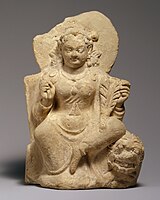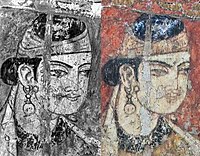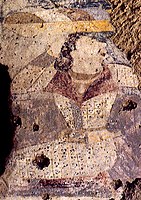Tokhara Yabghus
Tokhara Yabghus | |||||||||||||
|---|---|---|---|---|---|---|---|---|---|---|---|---|---|
| 625 CE–758 CE | |||||||||||||
Shuburgan had mints for Yabghu coinage. | |||||||||||||
| Capital | Kunduz | ||||||||||||
| Religion | Buddhism[4] | ||||||||||||
| Government | Monarchy | ||||||||||||
• c. 625 CE | Tardush Shad | ||||||||||||
| Historical era | Early Medieval | ||||||||||||
• Established | 625 CE | ||||||||||||
• Disestablished | 758 CE | ||||||||||||
| |||||||||||||
| Today part of | Afghanistan Pakistan Uzbekistan Tajikistan | ||||||||||||
The Tokhara Yabghus or Yabghus of Tokharistan (
Territorial expansion
The Turks initially occupied the area of north of the
First offensive into Tokharistan (569–570 CE)

In 569–570, the Turks launched an offensive against the Sasanian Empire, and conquered the Hephthalite principalities south of the Oxus belonging to the Sasanian Empire. At that time the Sasanian Empire was embroiled in a war in the west, with the Byzantine Empire. It seems the Turks reached the Kabul–Gandhara area in 570.[6] The principalities of the Hephthalites, formerly vassals of the Sasanian Empire, accepted Turk supremacy and became vassals of the Western Turk qaghan, and the Alchon Huns continued to rule in Kabul and Gandhara, but the Turks apparently did not permanently occupy the territory south of the Oxus.[6] The Hephthalites aspired to independence from the Turks, and in 581 or 582 CE, they revolted in alliance with the Sasanians against the Turk Kaghan Tardu.[6]
Second offensive into Tokharistan (588–589 CE)
In 588–589, the Turks under
War against the Sassanian Empire (616–617 CE)
A war broke out between the Sassanians and the Hephthalites in 606–607 or 616–617 CE, the
Occupation of Tokharistan under Tong Yabghu Qaghan (625 CE)
The Turks definitely intended to take control of the territories south of the Oxus, but were only ready sometime later, and took the opportunity when the Sasanian Empire again entered into conflict with the Byzantine Empire.[14]
In 625, Tong Yabgu invaded
According to
Tong Yabghu Qaghan then installed his son Tardush Shad (Chinese: 達頭设; pinyin: Dátóu Shè), as the first yabgu (sub-king) of Tokharistan, controlling all the new Turk realm south of the Oxus, from his capital at Kunduz.[14]
Reign of Tardush Shad (625–630)
Tardush Shad (Chinese: 達頭设; pinyin: Dátóu Shè) was installed in Tokharistan, and ruled in Kunduz with title of Tokharistan Yabgu (Chinese: 吐火羅葉護; pinyin: Tǔhuǒluó Yèhù). He was married two times – both a daughter of Qu Boya (麴伯雅) – ruler of Qocho. When Xuanzang visited Kunduz, he also brought a letter from his brother-in-law and ruler of Qocho Qu Wentai (麴文泰) to Tardu. Yabgu received him despite being in ill condition. It was Tardu to advise him to make a trip westward to Balkh (modern Afghanistan), to see the Buddhist sites and relics. Xuanzang also witnessed a palace scandal when Tardu's firstborn son Ishbara Tegin fallen in love with his new step-mother (also aunt) and poisoned Tardu in 630.[18]
Reign of Ishbara Yabgu (630–650)
Ishbara Yabgu (
After 650 however, the power of the Yabghus of Tokharistan fragmented, as they came, as least partially, under Tang suzerainty.[19] A Türk yabghu of Tokharistan recorded under the name of "Wu-shih-po of the A-shih-na dynasty" was the first yabghu to be confirmed by the Chinese Emperor.[20]
In 652–653 CE, the Arabs under
The
During the rule of the Umayyad caliph
Reign of Pantu Nili (c.705 CE)
In 705, P’an-tu-ni-li, the yabghu of Tokharistan, is recorded as having sent a mission to the Chinese court.
Suzerainty over the territories north and south of the Hindu-Kush

According to the chronicles of the Chinese Cefu Yuangui, a young brother of Pantu Nili named Puluo (僕羅 púluó in Chinese sources) again visited the Tang court in 718 and gave an account of the military forces in the Tokharistan region.[23] Puluo described the power of "the Kings of Tokharistan", explaining that "Two hundred and twelve kingdoms, governors and prefects" recognize the authority of the Yabghus, and that it has been so since the time of his grandfather, that is, probably since the time of the establishment of the Yabghus of Tokharistan.[24] This account also shows that the Yabghu of Tokharistan ruled a vast area circa 718 CE, formed of the territories north and south of the Hindu Kush, including the areas of Kabul and Zabul.[1] The territory of Guzgan was also mentioned among the territories controlled by the Yabghus.[24]
Part of the Chinese entry for this account by Puluo is:
六年十一月丁未阿史特勒僕羅上書訴曰:僕羅克吐火羅葉護部下管諸國王都督刺史總二百一十二人謝芄王統領兵馬二十萬眾潯齬王統領兵馬二十萬眾骨吐國王石汗那國王解蘇國王石匿國王悒達國王護密國王護時健國王範延國王久越德建國王勃特山王各領五萬眾。僕羅祖父已來並是上件諸國之王蕃望尊重。
On the Dingwei day of the eleventh month in the sixth year [of theQuwādhiyān,[l] and Badakhshan[m] each lead fifty thousand troops. Since the grandfather of Puluo, the Yehu Tuhuolo [Yabghu of Tokharistan] has become king of the above-mentioned states: he is greatly respected."

Puluo, writing in 718 CE, finally reaffirmed the loyalty of the Tokhara Yabghus towards the Tang dynasty, probably since the time of the fall of the
然火羅葉護積代已來,於大唐忠赤,朝貢不絕。
The Yabghus of Tokharistan, for several generations until now, have been sincerely devoted to the great Tang dynasty, they have without interruption paid their respects and brought tribute.
Temporary conquest of Khorasan over the Arabs (689–710 CE)
c. 689 CE, the
The Arabs of the
Contacts with the Byzantine Empire
The
Chinese sources
Turk ("T’u-chüeh") kingdoms were in the territories of Gandhara, Kapisa and
I arrived in Tokharistan (吐火羅國 Tuhuoluo-guo). The home city of the king is called
Chinese sources mention a few years later yabghus who sent missions to the Tang court: Ku-tu-lu Tun Ta-tu (Qutluγ Ton Tardu) asked for help against the Arabs in 729 CE, Shih-li-mang-kia-lo (Sri Mangala) asked for help against the Tibetans in 749 CE, and received this help from the Chinese, and in 758 CE Wu-na-to (Udita?) visited in person the Chinese court and participated in the fight against the rebel
In the
Kapisa-Gandhara
In the area of
c. 650 CE, the Arabs attacked Shahi territory from the west, and captured Kabul.[41] But the Turk Shahi were able to mount a counter-offensive and repulsed the Arabs, taking back the areas of Kabul and Zabulistan (around Ghazni), as well as the region of Arachosia as far as Kandahar.[41] The Arabs again failed to capture Kabul and Zabulistan in 697–698 CE, and their general Yazid ibn Ziyad was killed in the action.[41] A few years later however the Arabs defeated and killed the Kabul Shah and conquered Kabul under Umayyad general Qutayba ibn Muslim.[48][49][50]
Nezak Tarkhan, the ruler of the Hephthalites of Badghis, led a revolt against the Arabs in 709 with the support of other principalities as well as his nominal ruler, the
From 719 CE, Tegin Shah was the king of the Turk Shahis. He then abdicated in 739 CE in favour of his son Fromo Kesaro, probable phonetic transcription of "Caesar of Rome" in honor of "Caesar", the title of the then East Roman Emperor Leo III the Isaurian who had defeated their common enemy the Arabs in 717 CE, and sent an embassy through Central Asia in 719 CE.[41][p] Fromo Kesaro appears to have fought vigorously against the Arabs, and his victories may have forged the Tibetan epic legend of King Phrom Ge-sar.[41]
The Turk Shahis eventually weakened against the Arabs in the late 9th century CE.
Local art at the time of the Yabghus of Tokharistan (7th–8th century CE)
These was a relatively high level of artistic activity in the areas controlled by the Yabghus of Tokharistan during 7th–8th centuries CE, either as a result of the Sasanian cultural heritage, or as a result of the continued development of Buddhist art.[56] The works of art of this period in Afghanistan, with a sophistication and cosmopolitanism comparable to other works of art of the Silk Road such as those of Kizil, are attributable to the sponsorship of the Turks.[57]
-
Male mythological figure, Tokharistan, 7th–8th century CE
-
Shallow bowl, probably from Afghanistan (said to have been discovered in northwestern India), Sasanian period, 5th–7th century CE.[60]
-
Goddess, possibly Nana, seated on a lion, 5th–6th century, Afghanistan,Hephthalite or Turkic period.[61]
Buddhism
Buddhism in
-
Female devotee in Kalai Kafirnigan. 7th–early 8th century.[62]
-
Ajina-Tepe Buddhist mural, Tajikistan, 7th–8th century CE
-
Buddhist mural from the monastery atAjina Tepe. Dushanbe – National Museum of Antiquities.[62]
Bamiyan murals and their devotees
The mural paintings of Bamiyan display male devotees in double-lapel caftans, also attributable to the local sponsorship of the Western Turks.[57]
-
Devotee in double-lapelcaftan, left wall of the niche of the 53 meter Buddha. Bamiyan
-
The Buddha and devotee in caftan. Bamiyan
-
Devotee in caftan, next to the Buddha. Bamiyan (detail)
References
- ^ JSTOR 29757642.
- ^ Detailed list of vassal cities and regions in ancient Chinese sources: Taishan, Y. U. (2012). 歐亞學刊 新3辑 (Eurasian Studies III): Records Relevant to the Hephthalites in Ancient Chinese Historical Works. 中華書局. p. 250.
- ^ JSTOR 29757642.
- ^ ISBN 978-1-351-92605-8.
- ISBN 978-92-3-103211-0.
- ^ ISBN 978-92-3-103211-0.
- ^ Rezakhani 2017, p. 177.
- ^ Rezakhani 2017, p. 178.
- ISBN 978-81-208-1540-7.
- ISBN 978-1-83860-868-2.
- ^ Grenet, Frantz (2004). "Maracanda/Samarkand, une métropole pré-mongole". Annales. Histoire, Sciences Sociales. 5/6: Fig. B.
- ISBN 978-1-932476-13-2.
- ^ Yatsenko, Sergey A. (2009). "Early Turks: Male Costume in the Chinese Art Second half of the 6th – first half of the 8th cc. (Images of 'Others')". Transoxiana. 14: Fig.25.
- ^ ISBN 978-92-3-103211-0.
- )
- ISBN 978-9781412356.
- ^ "Cefu Yuangui, vol 999 | 冊府元龜/卷0999 – 维基文库,自由的图书馆". zh.wikisource.org (in Chinese). Retrieved 2018-08-21.
- OCLC 2959831.
- ^ ISBN 978-92-3-103211-0.
- ISBN 978-92-3-103211-0.
- ^ Theobald, Ulrich. "The Western Territories 西域 (www.chinaknowledge.de)". www.chinaknowledge.de.
- ^ ISBN 978-92-3-103211-0.
- ^ Kuwayama, S. (2002). Across the Hindukush of the First Millennium: a collection of the papers (PDF). Kyoto University. p. 139.
- ^ .
- ^ a b c d e f g h i j Taishan, Y. U. (2012). 歐亞學刊 新3辑 (Eurasian Studies III): Records Relevant to the Hephthalites in Ancient Chinese Historical Works. 中華書局. p. 250.
- ^ Theobald, Ulrich. "The Western Territories 西域". www.chinaknowledge.de.
- ^ Paragraph 69 in: "冊府元龜 : 卷九百九十九 – Chinese Text Project". ctext.org.
- ISBN 978-0-674-06538-3.
- ISBN 978-90-04-48294-4.
- ISBN 978-0-231-13924-3.
- ^ Paragraph 69 然火罗叶护积代以来于大唐忠赤朝贡不绝。in: "冊府元龜 : 卷九百九十九 – Chinese Text Project". ctext.org.
- ^ a b Beckwith 2009, p. 132.
- ^ a b c Bosworth, C.E. "BĀḎḠĪS". Encyclopaedia Iranica.
- ^ Kennedy 2007, pp. 243–254.
- ^ Grenet, F. "NĒZAK". Encyclopaedia Iranica. Citing Tangshu XLIII, B, pp. 6–9 and Chavannes, Documents, p. 69, n. 2
- ^ a b Gibb 1923, pp. 36–38.
- ^ a b Shaban 1970, pp. 66–67.
- JSTOR 600737.
- ^ ISBN 978-0895810243.
- ISBN 978-0895810243.
- ^ ISBN 978-1-317-34090-4.
- ^ Old Book of Tang (舊唐書 Jiu Tangshu), ch. 198 (written mid-10th century C.E.), for 618–906 C.E: "開元七年正月,其主遣吐火羅大首領獻獅子、羚羊各二。不數月,又遣大德僧來朝貢" quoted in English translation in Hirth, F. (1885). China and the Roman Orient: Researches into their Ancient and Mediaeval Relations as Represented in Old Chinese Records. Shanghai & Hong Kong: Kelly and Walsh.
- ISBN 978-0-8108-7283-7.
- ISBN 978-1-78673-316-0.
- ^ Göbl 1967, 254 ; Vondrovec tyre 254
- ^ "The Countenance of the other (The Coins of the Huns and Western Turks in Central Asia and India) 2012–2013 exhibit". Pro.geo.univie.ac.at. Kunsthistorisches Museum Vienna. Retrieved July 16, 2017.
- ^ Alram, Michael; Filigenzi, Anna; Kinberger, Michaela; Nell, Daniel; Pfisterer, Matthias; Vondrovec, Klaus. "The Countenance of the other (The Coins of the Huns and Western Turks in Central Asia and India) 2012–2013 exhibit: 13. THE TURK SHAHIS IN KABULISTAN". Pro.geo.univie.ac.at. Kunsthistorisches Museum Vienna. Retrieved July 16, 2017.
- ISBN 9781838933418.
- ^ Mujahid, Abdul Malik (1908). "Golden Words".
- ISBN 9789004282094.
- JSTOR 600737.
- ^ D. W. Macdowall, "The Shahis of Kabul and Gandhara" Numismatic Chronicle, Seventh Series, Vol. III, 1968, pp. 189–224, see extracts in R. T. Mohan, AFGHANISTAN REVISITED ... Appendix –B, pp. 164–68
- ^ Raizada Harichand Vaid, Gulshane Mohyali, II, pp. 83 and 183-84.
- H. G. Raverty, Tr. Tabaqat-i-Nasiri of Maulana Minhaj-ud-din, Vol. I, p. 82
- ^ "The Countenance of the other (The Coins of the Huns and Western Turks in Central Asia and India) 2012–2013 exhibit: 16. The Hindu Shahis in Kabulistan and Gandhara and the Arab conquest". Pro.geo.univie.ac.at. Retrieved July 22, 2017.
- ^ Compareti, Matteo (2008). "The Painting of the "Hunter-King" at Kakrak: Royal Figure or Divine Being?". Studio Editoriale Gordini: 133.
- ^ ISBN 978-1-351-88087-9.
- ^ Huntington, John C. "Images of the Crowned Buddha along the Silk Road: Iconography and Ideology".
- ISBN 978-981-4722-59-9.
- ^ Gunter, Ann C.; Jett, Paul (1992). ANCIENT IRANIAN METALWORK IN THE ARTHUR M. SACKLER GALLERY AND THE FREER GALLERY OF ART (PDF). Smithsonian Institution, Washin2;ton, D.C. pp. 148–152.
- ^ "Metropolitan Museum of Art". www.metmuseum.org.
- ^ ISBN 978-1-83860-868-2.
- JSTOR 29756581.
Notes
- ^ 葉護吐火羅 Yehu of Tuhuoluo[25]
- ^ 謝芄 Xieyang. "The state of Xieyang (Zābulistān) was located between Kabuland and Kandahar."[25]
- ^ 潯齬, Kabul or Jibin depending on the source.[25][3]
- ^ 骨吐國 Gutuo-guo
- ^ 石汗那國 Shihanna-guo "The state of Shihanna (Čaghaniyān) was located in Denau on the upper stream of the Surkhan River"[25]
- ^ 解蘇國 Jiesu-guo "The state of Jiesu was simply the state of Yuman (Shūmān) near presentday Dushanbe"[25]
- ^ 石匿國 Shini
- Mazār-e Sherif, Afghanistan)"[26]
- ^ 護密國 Humi-guo "The state of Humi (Komedae) was located in present-day Sarik-Čaupan and the surrounding area in the Wakhan valley."[25]
- ^ 護時健國 Hushijian-guo "The state of Hushijian (Gūzgānān) was located between Merv and Balkh"[25]
- ^ 範延國 Fanyan-guo
- Qobadian"[25]
- ^ 勃特山 Boteshan
- ^ Martin 2011, p. 127:"He received this laudatory epithet because he, like the Byzantines, was successful at holding back the Muslim conquerors."
- ISBN 978-1-62412-076-3.
- ^ Martin 2011, p. 127:"He received this laudatory epithet because he, like the Byzantines, was successful at holding back the Muslim conquerors."
Sources
- Alram, Michael; Filigenzi, Anna; Kinberger, Michaela; Nell, Daniel; Pfisterer, Matthias; Vondrovec, Klaus (2012–2013). "The Countenance of the other (The Coins of the Huns and Western Turks in Central Asia and India) 2012–2013 exhibit". Vienna, Austria: Kunsthistorisches Museum, Coin Cabinet. Retrieved 1 November 2020.
- Beckwith, Christopher (2009). Empires of the Silk Road. Princeton University Press.
- Rezakhani, Khodadad (2017). ReOrienting the Sasanians: East Iran in Late Antiquity. Edinburgh University Press. pp. 1–256. ISBN 9781474400305.
- ISBN 978-0-306-81740-3.
- Martin, Dan (2011). "Greek and Islamic Medicines' Historical Contact with Tibet". In Akasoy, Anna; Burnett, Charles; Yoeli-Tlalim, Ronit (eds.). Islam and Tibet: Interactions Along the Musk Routes. Farnham, Surrey: Ashgate Publishing. pp. 117–144. ISBN 978-0-7546-6956-2.
- Shaban, M. A. (1970). The ʿAbbāsid Revolution. Cambridge: Cambridge University Press. ISBN 0-521-29534-3.
- OCLC 499987512.

![Buddha wearing a crown and cape. Painting in niche "I" at Bamiyan, 7th century CE.[58][59]](http://upload.wikimedia.org/wikipedia/commons/thumb/b/ba/Buddha_wearing_a_crown_and_cape._Painting_in_niche_I_at_Bamiyan%2C_7th_century_CE.jpg/175px-Buddha_wearing_a_crown_and_cape._Painting_in_niche_I_at_Bamiyan%2C_7th_century_CE.jpg)









